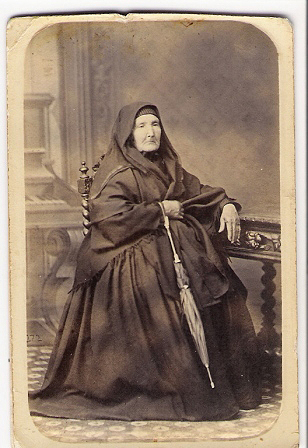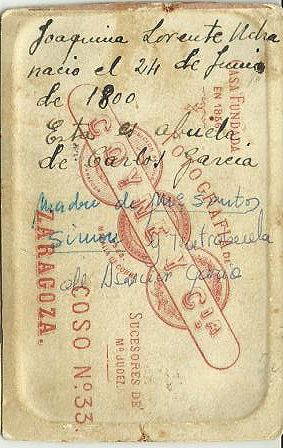The piece of the month of July 2015
PORTRAIT OF A MATRON. JOAQUINA LORENTE UCHA (1800-1883)
Esteban Orta Rubio
Full Professor retired from high school
It is not easy for our homes today to preserve photographs taken in the 19th century. The fact is even rarer if we move out of the affluent urban classes and into the rural world. Nevertheless, there are still remnants of family albums lovingly kept by pious hands. This is the case of the Simón-García family, from Murchante (Navarra), which has kept through several generations a photograph from the 1870s depicting a woman in her old age. Today it is kept by Asunción García Hernández, great-great-granddaughter of the portrayed woman.
The photo
The full-length seated portrait is of an elderly woman dressed in the style of the time in a wide-skirted dress. The figure, where blacks predominate, stands out against the gray of the background. She covers her head with a cloak, also black, which she holds to her chest with her right hand, while her left hand rests softly on a table in the studio. She is seated on a chair whose back appears briefly, creating a separation between the person and the background. Among the folds of her skirt that spill to the floor, a colored umbrella stands out, held in her right hand. The pinkish whiteness of the face and hands also stands out. Despite her advanced age, the lady communicates a sense of strength, and her face conveys serenity. The protruding chin stands out, indicative of a strong personality. Her name was Joaquina Lorente Ucha, a native and neighbor of Murchante, and she had made the trip to Zaragoza, which indicates her good health. She was in her eighties and had been a widow for some time.

Portrait of Joaquina Lorente
Anselmo María Coyne, c. 1877-1883
The photograph bears on the back the stamp of the studio where it was taken: "Coyne y Cía". Zaragoza. This is Anselmo María Coyne (1829-1896), born in Pamplona, of Irish origin and founder -around 1867- of a studio "Fotografía pamplonesa", located at place del Castillo. At an undetermined date he moved to the Aragonese capital where he collaborated with the famous photographer Mariano Júdez in the photographic office located at 33 Coso Street, forming the company "Júdez y Coyne". Later, in 1877, after his death, the company was renamed "Coyne y compañía, sucesores de Júdez", thus using the prestige achieved by his partner. Anselmo María Coyne was the initiator of a saga of photographers and filmmakers that has continued to the present day.
The photo can be framed between 1877 and 1883. In fact, it is from 1877 when the anagram "Coyne y Cía" appears, and it had to be taken before 1883 since the lady died in that year. We must also highlight the importance of this photograph to know the subject of work that Anselmo Coyne made in his first period, before a fire on May 9, 1887 destroyed the studio and the file stored in it.

Reverse side of photograph by Joaquina Lorente.
Coyne Photography. Zaragoza
A woman in the shadows
Joaquina was born in Murchante in June 1800 and was the daughter of Pascual Lorente and Teresa Ucha, from Tudela. The surname Lorente was quite extended at that time in the town and several of its members were dedicated to the teaching; it stood out, among them, Francisco Lorente, of liberal ideas, who worked as a teacher in the first third of the XIX century.
She was a child when the vicissitudes of the War of Independence (1808-1814) took place, and she must have kept in her memory at report the overwhelming scenes of the Battle of Tudela, on November 22, 1808, with the occupation and subsequent sacking of Murchante by the French soldiers. She married very young -possibly in 1819- to Bernardo Simón, forming a well-to-do marriage of class , well-matched and deeply religious. They had nine children. The husband, who belonged to the Simón saga, was an important person in the local area and remained closely linked to the wine business. He was followed by his sons, Martín and Manuel, good winemakers and breeders of fine wines that received awards at fairs and exhibitions. They were also both members of association Vinícola Navarra, which did so much to promote the province's vineyards.
While the men took the awards, Joaquina Lorente Ucha, like so many women of her time, lived inwardly, dedicated to the care and Education of her numerous offspring, while at the same time promoting family initiatives. Joaquina lived a very long life, no less than 83 years, something unusual at the time. She was widowed in 1873, after the death of her husband Bernardo, whom she survived for ten years. God granted her a quick death, as she died at 1:00 a.m. on November 5, 1883, as a result of angina pectoris. He did not receive any sacrament because of the suddenness of the accident.
Such a long life allowed him to know many grandchildren. Florentino Simón Garriga (1868-1935), who became bishop of the diocese of San José de Tocatíns, in Brazil. Braulio Martínez Simón, a famous professor who was murdered in the Republican zone during the Civil War and who is in the process of beatification. On the other hand, two of the granddaughters, the sisters Ángeles and Araceli Simón Osés, were founders of the Congregation Esclavas de Cristo Rey, created by the Venerable D. Pedro Legaria, then parish priest of Murchante.
bibliography
-CASTRO, Antón: "Los Coyne: el arte de mirar a lo largo de 150 años", in Pedro Avellaned (curator): Coyne, Gobierno de Aragón, Zaragoza, 2003.
-MIGUÉLIZ VALCARLOS, I., "Fotógrafos navarros en la Colección Fotográfica del Marqués de la Real Defensa", Cuadernos de la Chair de Patrimonio y Arte Navarro, nº 6, 2011, pp. 217-260.
-ORTA RUBIO, E., La Saga de los García. A part of the history of Murchante, Murchante, 2010.
-ORTA RUBIO, E., Murchante. La larga lucha por su libertad, Murchante, 1989.
-SÁNCHEZ MILLÁN, A. ROMERO, A. y TARTÓN, C., Los Coyne. 100 years of photography, DPZ, Zaragoza, 1988.
